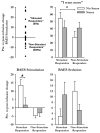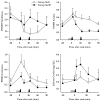Bidirectional interactions between acute psychosocial stress and acute intravenous alcohol in healthy men
- PMID: 21762177
- PMCID: PMC3183385
- DOI: 10.1111/j.1530-0277.2011.01522.x
Bidirectional interactions between acute psychosocial stress and acute intravenous alcohol in healthy men
Abstract
Background: The biological mechanisms by which acute stress increases alcohol consumption are unclear. One potential mechanism is that stress acts by altering the pharmacological and subjective effects of alcohol. Acute stress produces a cascade of physiological and psychological effects, each with a distinctive time course. In this study, we investigated whether different phases of response to an acute stress alter the subjective effects of intravenous alcohol, by administering the drug at 2 different times after the stress.
Methods: Healthy men (n = 25) participated in 2 sessions: 1 with the Trier Social Stress Test and the other with a nonstressful control task, each followed by infusions of intravenous alcohol (targeting 40 mg% in 5 minutes) and placebo. One group of participants received alcohol within 1 minute of completing the tasks (Alc0, n = 11), followed by placebo 30 minutes later. In the other group (Alc30, n = 14), the order of alcohol and placebo infusions was reversed. Subjective effects (i.e., anxiety, stimulation, want more) and physiological measures (heart rate, blood pressure, salivary cortisol) were measured before and at repeated intervals after the tasks and infusions.
Results: Stress did not change the subjective effects of alcohol in either group. However, when individual differences in alcohol responses were considered, stress differentially altered the stimulant-like and sedative effects of alcohol. Among individuals who exhibited predominantly stimulant responses to alcohol in the nonstressful condition, stress decreased the stimulant-like effects of alcohol and "wanting more." By contrast, among participants who did not report stimulation after alcohol in the control session, stress decreased the sedative effects and increased "want more." In addition, alcohol administered immediately after the Trier Social Stress Test dampened cortisol responses yet prolonged negative subjective responses to the stress.
Conclusions: These findings demonstrate that there are bidirectional relationships between alcohol and stress. Alcohol influences responses to stress, and stress changes reactions to alcohol, depending on an individual's pattern of response to alcohol. This study highlights the fact that stress-alcohol interactions vary among individual drinkers, suggesting that the effects of stress on motivation to drink alcohol may also differ between individuals.
Copyright © 2011 by the Research Society on Alcoholism.
Figures




References
-
- al'Absi M, Wittmers LE, Erickson J, Hatsukami D, Crouse B. Attenuated adrenocortical and blood pressure responses to psychological stress in ad libitum and abstinent smokers. Pharmacol Biochem Behav. 2003;74(2):401–10. - PubMed
-
- Antoni FA. Hypothalamic control of adrenocorticotropin secretion: advances since the discovery of 41-residue corticotropin-releasing factor. Endocr Rev. 1986;7(4):351–78. - PubMed
-
- APA. Diagnostic and Statistical Manual of Psychiatry. 4th. Washinton DC: 1994.
-
- Bitran D, Shiekh M, McLeod M. Anxiolytic effect of progesterone is mediated by the neurosteroid allopregnanolone at brain GABAA receptors. J Neuroendocrinol. 1995;7(3):171–7. - PubMed
-
- Blanchard RJ, Yudko EB, Blanchard DC. Alcohol, aggression and the stress of subordination. J Stud Alcohol Suppl. 1993;11:146–55. - PubMed
Publication types
MeSH terms
Substances
Grants and funding
LinkOut - more resources
Full Text Sources
Medical

